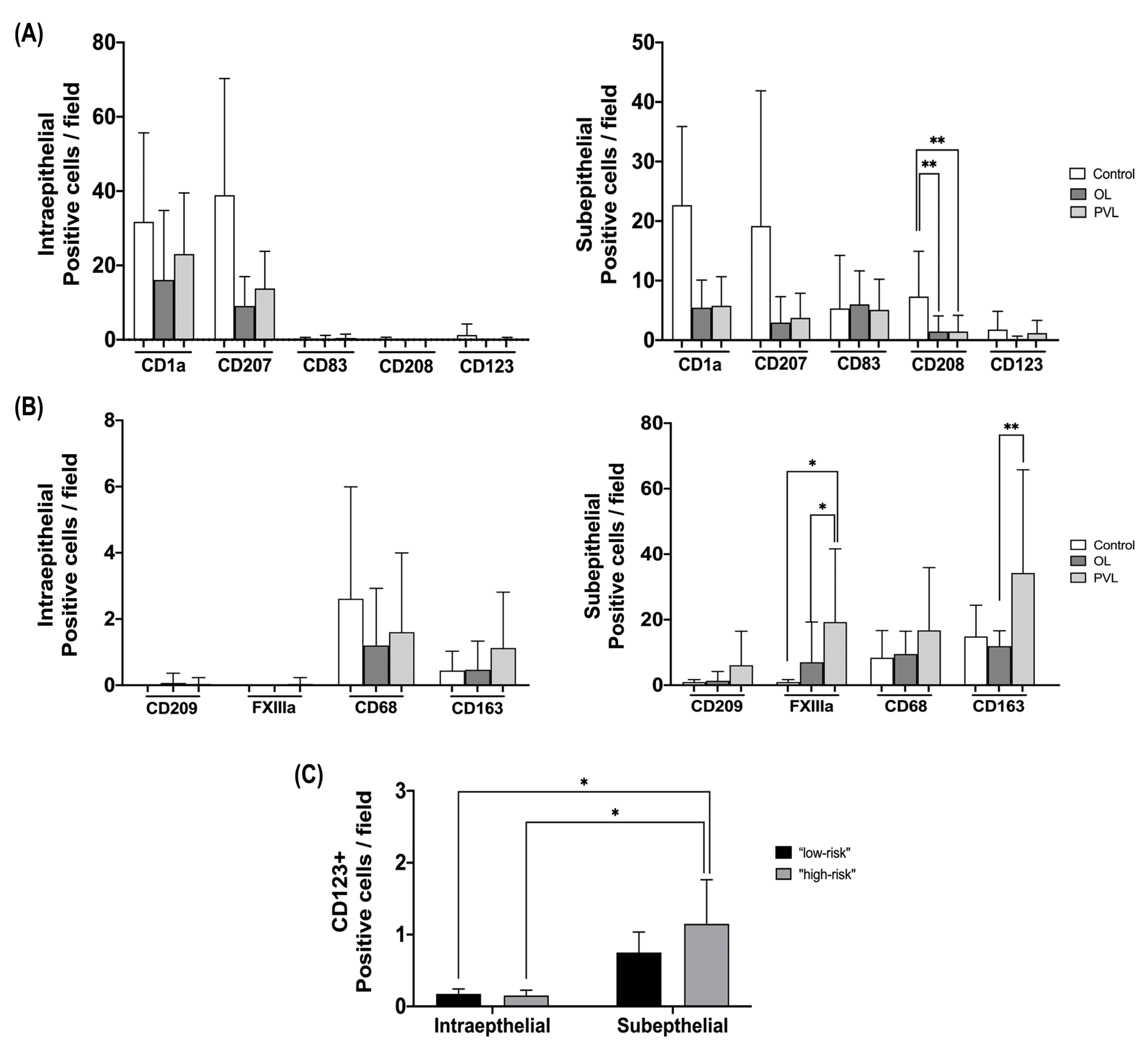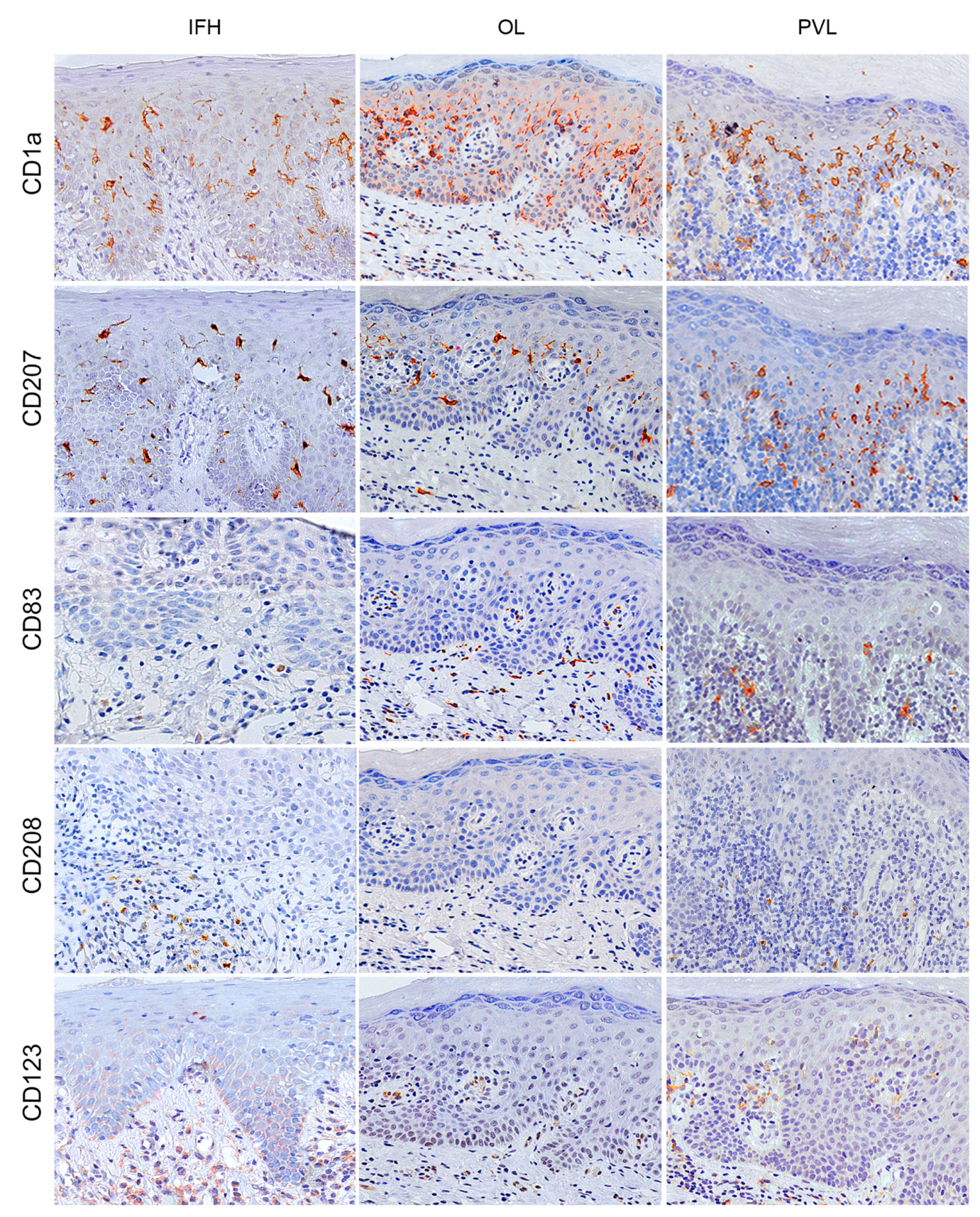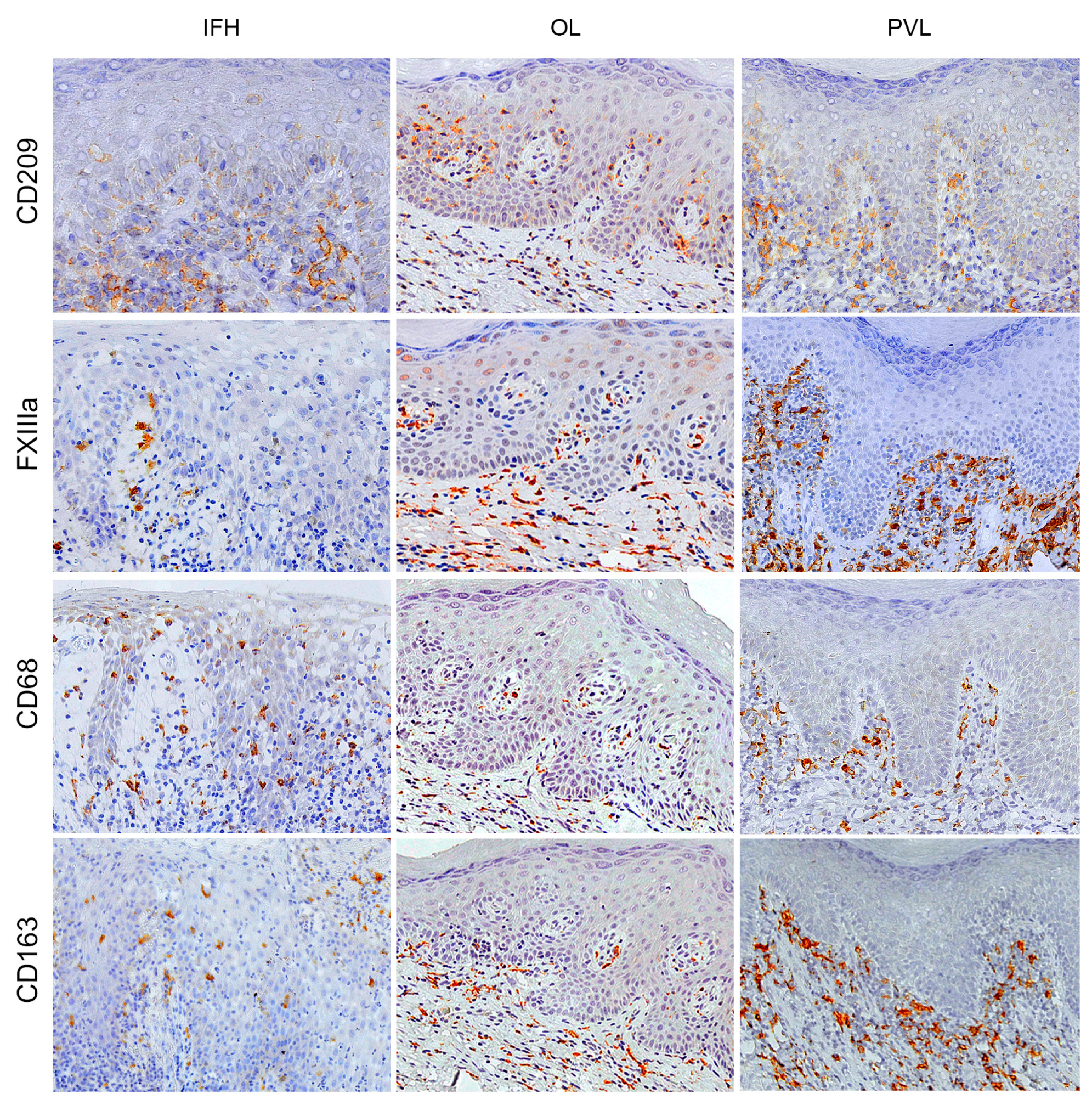Macrophages CD163+ and Factor XIIIa+ Provide a First-Line Defence against Proliferative Verrucous Leukoplakia Antigens
Abstract
1. Introduction
2. Results
2.1. Clinicopathological Features of OL and PVL Patients
2.2. Assessment of Density and Distribution of Dendritic Cells and Macrophages
2.3. Multivariate Analysis of Variance with Four Independent Factors
2.4. Dendritic Cells and Macrophages Markers Correlation in OL and PVL
3. Discussion
4. Materials and Methods
4.1. Study Population
4.2. Immunohistochemical Analysis
4.3. Statistical Analysis
5. Conclusions
Author Contributions
Funding
Institutional Review Board Statement
Informed Consent Statement
Data Availability Statement
Conflicts of Interest
References
- Ramos-García, P.; González-Moles, M.Á.; Mello, F.W.; Bagan, J.V.; Warnakulasuriya, S. Malignant transformation of oral proliferative verrucous leukoplakia: A systematic review and meta-analysis. Oral Dis. 2021, 27, 1896–1907. [Google Scholar] [CrossRef]
- Warnakulasuriya, S.; Kujan, O.; Aguirre-Urizar, J.M.; Bagan, J.V.; González-Moles, M.Á.; Kerr, A.R.; Lodi, G.; Mello, F.W.; Monteiro, L.; Ogden, G.R.; et al. Oral potentially malignant disorders: A consensus report from an international seminar on nomenclature and classification, convened by the WHO Collaborating Centre for Oral Cancer. Oral Dis. 2021, 27, 1862–1880. [Google Scholar] [CrossRef] [PubMed]
- Torrejon-Moya, A.; Jané-Salas, E.; López-López, J. Clinical manifestations of oral proliferative verrucous leukoplakia: A systematic review. J. Oral Pathol. Med. 2020, 49, 404–408. [Google Scholar] [CrossRef] [PubMed]
- Fernandes, D.; Barbeiro, C.O.; Palaçon, M.P.; Biancardi, M.R.; Ferrisse, T.M.; Silveira, H.A.; Castilho, R.M.; de Almeida, L.Y.; Leon, J.E.; Bufalino, A. High density of CD8 T cell and immune imbalance of T lymphocytes subsets are associated with proliferative verrucous leukoplakia. Immunology 2022, 168, 96–109. [Google Scholar] [CrossRef]
- Muntjewerff, E.M.; Meesters, L.D.; van den Bogaart, G. Antigen Cross-Presentation by Macrophages. Front. Immunol. 2020, 11, 1276. [Google Scholar] [CrossRef]
- Jhunjhunwala, S.; Hammer, C.; Delamarre, L. Antigen presentation in cancer: Insights into tumour immunogenicity and immune evasion. Nat. Rev. Cancer 2021, 21, 298–312. [Google Scholar] [CrossRef] [PubMed]
- Upadhyay, J.; Rao, N.N.; Upadhyay, R.B. A comparative analysis of langerhans cell in oral epithelial dysplasia and oral squamous cell carcinoma using antibody CD-1a. J. Cancer Res. Ther. 2012, 8, 591–597. [Google Scholar] [CrossRef] [PubMed]
- Kujan, O.; van Schaijik, B.; Farah, C.S. Immune Checkpoint Inhibitors in Oral Cavity Squamous Cell Carcinoma and Oral Potentially Malignant Disorders: A Systematic Review. Cancers 2020, 12, 1937. [Google Scholar] [CrossRef]
- Öhman, J.; Magnusson, B.; Telemo, E.; Jontell, M.; Hasséus, B. Langerhans cells and T cells sense cell dysplasia in oral leukoplakias and oral squamous cell carcinomas—Evidence for immunosurveillance. Scand. J. Immunol. 2012, 76, 39–48. [Google Scholar] [CrossRef] [PubMed]
- Mori, K.; Haraguchi, S.; Hiori, M.; Shimada, J.; Ohmori, Y. Tumor-associated macrophages in oral premalignant lesions coexpress CD163 and STAT1 in a Th1-dominated microenvironment. BMC Cancer 2015, 15, 573. [Google Scholar] [CrossRef] [PubMed]
- Stasikowska-Kanicka, O.; Wągrowska-Danilewicz, M.; Danilewicz, M. T cells are involved in the induction of macrophage phenotypes in oral leukoplakia and squamous cell carcinoma-a preliminary report. J. Oral Pathol. Med. 2018, 47, 136–143. [Google Scholar] [CrossRef] [PubMed]
- Töröcsik, D.; Bárdos, H.; Hatalyák, Z.; Dezső, B.; Losonczy, G.; Paragh, L.; Péter, Z.; Balázs, M.; Remenyik, E.; Adány, R. Detection of factor XIII-A is a valuable tool for distinguishing dendritic cells and tissue macrophages in granuloma annulare and necrobiosis lipoidica. J. Eur. Acad. Dermatol. Venereol. 2014, 28, 1087–1096. [Google Scholar] [CrossRef]
- Ochoa, M.T.; Loncaric, A.; Krutzik, S.R.; Becker, T.C.; Modlin, R.L. “Dermal dendritic cells” comprise two distinct populations: CD1+ dendritic cells and CD209+ macrophages. J. Invest. Dermatol. 2008, 128, 2225–2231. [Google Scholar] [CrossRef]
- Roquilly, A.; Mintern, J.D.; Villadangos, J.A. Spatiotemporal Adaptations of Macrophage and Dendritic Cell Development and Function. Annu. Rev. Immunol. 2022, 40, 525–557. [Google Scholar] [CrossRef] [PubMed]
- Bennaceur, K.; Chapman, J.; Brikci-Nigassa, L.; Sanhadji, K.; Touraine, J.L.; Portoukalian, J. Dendritic cells dysfunction in tumour environment. Cancer Lett. 2008, 272, 186–196. [Google Scholar] [CrossRef] [PubMed]
- Jardim, J.F.; Gondak, R.; Galvis, M.M.; Pinto, C.A.L.; Kowalski, L.P. A decreased peritumoral CD1a+ cell number predicts a worse prognosis in oral squamous cell carcinoma. Histopathology 2018, 72, 905–913. [Google Scholar] [CrossRef]
- Kindt, N.; Descamps, G.; Seminerio, I.; Bellier, J.; Lechien, J.R.; Pottier, C.; Larsimont, D.; Journé, F.; Delvenne, P.; Saussez, S. Langerhans cell number is a strong and independent prognostic factor for head and neck squamous cell carcinomas. Oral Oncol. 2016, 62, 1–10. [Google Scholar] [CrossRef]
- Datta, J.; Berk, E.; Cintolo, J.A.; Xu, S.; Roses, R.E.; Czerniecki, B.J. Rationale for a Multimodality Strategy to Enhance the Efficacy of Dendritic Cell-Based Cancer Immunotherapy. Front. Immunol. 2015, 6, 271. [Google Scholar] [CrossRef]
- Sato, K.; Fujita, S. Dendritic cells: Nature and classification. Allergol. Int. 2007, 56, 183–191. [Google Scholar] [CrossRef]
- Almand, B.; Resser, J.R.; Lindman, B.; Nadaf, S.; Clark, J.I.; Kwon, E.D.; Carbone, D.P.; Gabrilovich, D.I. Clinical significance of defective dendritic cell differentiation in cancer. Clin. Cancer Res. 2000, 6, 1755–1766. [Google Scholar]
- Souto, G.R.; Matias, M.D.P.; Nunes, L.F.M.; Ferreira, R.C.; Mesquita, R.A. Mature dendritic cell density is affected by smoking habit, lesion size, and epithelial dysplasia in oral leukoplakia samples. Arch. Oral Biol. 2018, 95, 51–57. [Google Scholar] [CrossRef]
- Bondad-Palmario, G.G. Histological and immunochemical studies of oral leukoplakia: Phenotype and distribution of immunocompetent cells. J. Philipp. Dent. Assoc. 1995, 47, 3–18. [Google Scholar] [CrossRef]
- Ni, Y.H.; Huang, X.F.; Ding, L.; Wang, Z.Y.; Hu, Q.G.; Hou, Y.Y. Accumulation of CD208+ mature dendritic cells does not correlate with survival time in oral squamous cell carcinoma patients. J. Oral Maxillofac. Surg. 2014, 72, 2178–2185. [Google Scholar] [CrossRef]
- Pellicioli, A.C.A.; Bingle, L.; Farthing, P.; Lopes, M.A.; Martins, M.D.; Vargas, P.A. Immunosurveillance profile of oral squamous cell carcinoma and oral epithelial dysplasia through dendritic and T-cell analysis. J. Oral Pathol. Med. 2017, 46, 928–933. [Google Scholar] [CrossRef] [PubMed]
- Hume, D.A. The Many Alternative Faces of Macrophage Activation. Front. Immunol. 2015, 6, 370. [Google Scholar] [CrossRef] [PubMed]
- Wang, L.X.; Zhang, S.X.; Wu, H.J.; Rong, X.L.; Guo, J. M2b macrophage polarization and its roles in diseases. J. Leukoc. Biol. 2019, 106, 345–358. [Google Scholar] [CrossRef] [PubMed]
- Weber, M.; Wehrhan, F.; Baran, C.; Agaimy, A.; Büttner-Herold, M.; Öztürk, H.; Neubauer, K.; Wickenhauser, C.; Kesting, M.; Ries, J. Malignant transformation of oral leukoplakia is associated with macrophage polarization. J. Transl. Med. 2020, 18, 11. [Google Scholar] [CrossRef]
- Troiano, G.; Caponio, V.C.A.; Adipietro, I.; Tepedino, M.; Santoro, R.; Laino, L.; Lo Russo, L.; Cirillo, N.; Lo Muzio, L. Prognostic significance of CD68+ and CD163+ tumor associated macrophages in head and neck squamous cell carcinoma: A systematic review and meta-analysis. Oral Oncol. 2019, 93, 66–75. [Google Scholar] [CrossRef]
- Cerio, R.; Griffiths, C.E.; Cooper, K.D.; Nickoloff, B.J.; Headington, J.T. Characterization of factor XIIIa positive dermal dendritic cells in normal and inflamed skin. Br. J. Dermatol. 1989, 121, 421–431. [Google Scholar] [CrossRef]
- Deguchi, M.; Aiba, S.; Ohtani, H.; Nagura, H.; Tagami, H. Comparison of the distribution and numbers of antigen-presenting cells among T-lymphocyte-mediated dermatoses: CD1a+, factor XIIIa+, and CD68+ cells in eczematous dermatitis, psoriasis, lichen planus and graft-versus-host disease. Arch. Dermatol. Res. 2002, 294, 297–302. [Google Scholar] [CrossRef]
- Fivenson, D.P.; Nickoloff, B.J. Distinctive dendritic cell subsets expressing factor XIIIa, CD1a, CD1b and CD1c in mycosis fungoides and psoriasis. J. Cutan. Pathol. 1995, 22, 223–228. [Google Scholar] [CrossRef] [PubMed]
- O’Donnell, R.K.; Mick, R.; Feldman, M.; Hino, S.; Wang, Y.; Brose, M.S.; Muschel, R.J. Distribution of dendritic cell subtypes in primary oral squamous cell carcinoma is inconsistent with a functional response. Cancer Lett. 2007, 255, 145–152. [Google Scholar] [CrossRef]
- Calik, M.; Calik, I.; Artas, G.; Ozercan, I.H. Prognostic Value of TRPM7 Expression and Factor XIIIa-Expressing Tumor-Associated Macrophages in Gastric Cancer. Gastroenterol. Res. Pract. 2021, 2021, 7249726. [Google Scholar] [CrossRef] [PubMed]
- Kersten, K.; Hu, K.H.; Combes, A.J.; Samad, B.; Harwin, T.; Ray, A.; Rao, A.A.; Cai, E.; Marchuk, K.; Artichoker, J.; et al. Spatiotemporal co-dependency between macrophages and exhausted CD8+ T cells in cancer. Cancer Cell 2022, 40, 624–638.e9. [Google Scholar] [CrossRef] [PubMed]
- Kujan, O.; Agag, M.; Smaga, M.; Vaishnaw, Y.; Idrees, M.; Shearston, K.; Farah, C.S. PD-1/PD-L1, Treg-related proteins, and tumour-infiltrating lymphocytes are associated with the development of oral squamous cell carcinoma. Pathology 2022, 54, 409–416. [Google Scholar] [CrossRef]
- Kujan, O.; Oliver, R.J.; Khattab, A.; Roberts, S.A.; Thakker, N.; Sloan, P. Evaluation of a new binary system of grading oral epithelial dysplasia for prediction of malignant transformation. Oral Oncol. 2006, 42, 987–993. [Google Scholar] [CrossRef]



| Clinicopathological features | OL (n = 20) | PVL (n = 12) |
|---|---|---|
| n (%) | n (%) | |
| Average age (years) | 53.3 | 64.3 |
| Gender | ||
| Male | 13 (65.0) | 6 (50.0) |
| Female | 7 (35.0) | 6 (50.0) |
| Ethnicity | ||
| White | 17 (85.0) | 12 (100) |
| Nonwhite | 3 (15.0) | 0 (0.0) |
| Tobacco | ||
| No | 7 (35.0) | 8 (66.7) |
| Yes | 13 (65.0) | 4 (33.3) |
| Alcohol | ||
| No | 20 (86.9) | 10 (83.3) |
| Yes | 3 (13.1) | 2 (16.7) |
| Oral sites ++ | ||
| Right buccal mucosa | 4 (20.0) | 6 (50.0) |
| Left buccal mucosa | 4 (20.0) | 6 (50.0) |
| Floor of the mouth | 0 (0.0) | 4 (33.3) |
| Maxillary gingivae | 0 (0.0) | 2 (16.7) |
| Mandibular gingivae | 2 (10.0) | 4 (33.3) |
| Upper labial mucosa | 0 (0.0) | 2 (16.7) |
| Lower labial mucosa | 1 (5.0) | 2 (16.7) |
| Tongue | 7 (35.0) | 5 (41.7) |
| Palate | 2 (10.0) | 3 (25.0) |
| Binary system of dysplasia grade ++ | ||
| Low risk | 13 (65.0) | 16 (59.3) |
| High risk | 7 (35.0) | 11 (40.7) |
| Malignant transformation | ||
| No | 17 (85.0) | 5 (41.7) |
| Yes | 3 (15.0) | 7 (58.3) |
| Recurrence | ||
| No | 20 (100) | 3 (25.0) |
| Yes | 0 (0.0) | 9 (75.0) |
| OL | PVL | ||||||
|---|---|---|---|---|---|---|---|
| Markers | p-Value | r | R2 | p-Value | r | R2 | |
| CD1a | CD209 | 0.4052 | −0.1969 | 0.0388 | 0.6081 | 0.1033 | 0.0107 |
| CD1a | FXIIIa | 0.0844 | 0.3954 | 0.1563 | 0.0494 | 0.3817 | 0.1457 |
| CD1a | CD68 | 0.0891 | 0.3900 | 0.1521 | 0.1009 | 0.3224 | 0.1039 |
| CD1a | CD163 | 0.0863 | 0.3951 | 0.1561 | 0.1238 | 0.3034 | 0.0921 |
| CD207 | CD209 | 0.4395 | −0.1832 | 0.0335 | 0.5202 | 0.1294 | 0.0167 |
| CD207 | FXIIIa | 0.7874 | 0.0644 | 0.0041 | 0.2285 | 0.2397 | 0.0574 |
| CD207 | CD68 | 0.5933 | 0.1271 | 0.0162 | 0.0108 | 0.4825 | 0.2328 |
| CD207 | CD163 | 0.4042 | 0.1974 | 0.039 | 0.0784 | 0.3445 | 0.1187 |
| CD83 | CD209 | 0.7969 | 0.0615 | 0.0038 | 0.0792 | 0.3436 | 0.1181 |
| CD83 | FXIIIa | 0.1267 | 0.3531 | 0.1247 | 0.0199 | 0.4452 | 0.1982 |
| CD83 | CD68 | 0.0058 | 0.5933 | 0.352 | <0.0001 | 0.6852 | 0.4695 |
| CD83 | CD163 | 0.2093 | 0.2934 | 0.0861 | 0.0010 | 0.5958 | 0.3550 |
| CD208 | CD209 | 0.3515 | 0.2199 | 0.0484 | 0.0867 | 0.3359 | 0.1128 |
| CD208 | FXIIIa | 0.8750 | 0.0376 | 0.0014 | 0.0055 | 0.5195 | 0.2699 |
| CD208 | CD68 | 0.0309 | 0.4830 | 0.2333 | 0.0046 | 0.5284 | 0.2793 |
| CD208 | CD163 | 0.2979 | 0.2449 | 0.0600 | 0.0318 | 0.4139 | 0.1713 |
| CD123 | CD209 | 0.4605 | −0.175 | 0.0306 | 0.0087 | 0.4948 | 0.2448 |
| CD123 | FXIIIa | 0.9569 | −0.0129 | 0.0002 | 0.5526 | −0.1195 | 0.0143 |
| CD123 | CD68 | 0.9750 | −0.0075 | 0.0001 | 0.5364 | 0.1244 | 0.0155 |
| CD123 | CD163 | 0.5894 | 0.1284 | 0.0165 | 0.8455 | 0.0393 | 0.0015 |
Disclaimer/Publisher’s Note: The statements, opinions and data contained in all publications are solely those of the individual author(s) and contributor(s) and not of MDPI and/or the editor(s). MDPI and/or the editor(s) disclaim responsibility for any injury to people or property resulting from any ideas, methods, instructions or products referred to in the content. |
© 2023 by the authors. Licensee MDPI, Basel, Switzerland. This article is an open access article distributed under the terms and conditions of the Creative Commons Attribution (CC BY) license (https://creativecommons.org/licenses/by/4.0/).
Share and Cite
Palaçon, M.P.; de Oliveira Barbeiro, C.; Fernandes, D.; Biancardi, M.R.; Silveira, H.A.; Ferrisse, T.M.; León, J.E.; Kujan, O.; Bufalino, A. Macrophages CD163+ and Factor XIIIa+ Provide a First-Line Defence against Proliferative Verrucous Leukoplakia Antigens. Int. J. Mol. Sci. 2023, 24, 5242. https://doi.org/10.3390/ijms24065242
Palaçon MP, de Oliveira Barbeiro C, Fernandes D, Biancardi MR, Silveira HA, Ferrisse TM, León JE, Kujan O, Bufalino A. Macrophages CD163+ and Factor XIIIa+ Provide a First-Line Defence against Proliferative Verrucous Leukoplakia Antigens. International Journal of Molecular Sciences. 2023; 24(6):5242. https://doi.org/10.3390/ijms24065242
Chicago/Turabian StylePalaçon, Mariana Paravani, Camila de Oliveira Barbeiro, Darcy Fernandes, Mariel Ruivo Biancardi, Heitor Albergoni Silveira, Túlio Morandin Ferrisse, Jorge Esquiche León, Omar Kujan, and Andreia Bufalino. 2023. "Macrophages CD163+ and Factor XIIIa+ Provide a First-Line Defence against Proliferative Verrucous Leukoplakia Antigens" International Journal of Molecular Sciences 24, no. 6: 5242. https://doi.org/10.3390/ijms24065242
APA StylePalaçon, M. P., de Oliveira Barbeiro, C., Fernandes, D., Biancardi, M. R., Silveira, H. A., Ferrisse, T. M., León, J. E., Kujan, O., & Bufalino, A. (2023). Macrophages CD163+ and Factor XIIIa+ Provide a First-Line Defence against Proliferative Verrucous Leukoplakia Antigens. International Journal of Molecular Sciences, 24(6), 5242. https://doi.org/10.3390/ijms24065242







